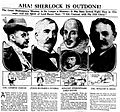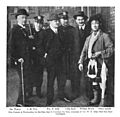William Selig facts for kids
Quick facts for kids
William Nicholas Selig
|
|
|---|---|

Selig in 1916
|
|
| Born | March 14, 1864 |
| Died | July 15, 1948 (aged 84) Los Angeles, California, U.S.
|
| Other names | "Colonel" Selig Col. William N. Selig Col. William Selig W.N. Selig William N. Selig Wm. N. Selig |
William Nicholas Selig (born March 14, 1864 – died July 15, 1948) was an important person in the early days of American movies. He started as a performer in vaudeville, which was a popular type of stage show with different acts like singing, dancing, and comedy. Later, he became a pioneer in the motion picture industry, helping to create the movies we watch today.
He was known as Colonel Selig throughout his career, even when he moved from performing to making films. William Selig was born in Chicago to immigrant parents. He first learned to be an upholsterer, someone who makes and repairs furniture. But he soon found his passion in show business.
In 1896, Selig started one of the very first companies to make movies, called the Selig Polyscope Company in Chicago. He made many successful films early on. His movie The Tramp and the Dog (1896) is thought to be the first story-based film made in Chicago. He might also have made the first story film shot in Los Angeles, The Count of Monte Cristo (1908). In 1909, he opened the first permanent movie studio in Los Angeles, in a place called Edendale, Los Angeles.
Selig also produced the first Wizard of Oz movie in 1910. He made Damon and Pythias (1908), which was one of the first longer films, lasting about 20 minutes. He also created The Adventures of Kathlyn (1913–1914), which was one of the first true movie serials, a story told in many parts.
Contents
Early Life and Show Business
William Nicholas Selig was born on March 14, 1864, in Chicago, Illinois. His parents, Antonia and Joseph Franz Selig, were immigrants from Bohemia and Poland. He grew up in a part of Chicago where many Polish families lived and went to primary school there.
Selig began his career in show business as a magician. He called himself "Selig the Conjurer." He also toured the Midwest as a performer in his own minstrel show. Later, he settled in San Francisco and continued to tour as a magician. One famous actor who worked with him was Bert Williams, who became a very important African-American entertainer. Selig later gave himself the honorary title of Colonel.
How Selig Started Making Movies
In 1894, Selig visited the Texas State Fair in Dallas, Texas. There, he saw people from Thomas Edison’s laboratory showing off the Kinetoscope, an early movie viewer. This inspired him to make his own moving pictures. He wanted to do this without paying fees to Edison's company.
Selig went back to Chicago and opened a small photography studio. He started trying to figure out how to make his own film equipment. He found a metalworker who had fixed a Lumière brothers movie camera without knowing what it was. With the help of this metalworker and another machinist named Andrew Schutsek, Selig developed his own movie camera and projector.
In 1896, Selig founded the Selig Polyscope Company in Chicago. This was one of the first motion picture studios in America. They made not only movies but also film equipment. At first, they made short films showing real events, travel films, and industrial films for businesses in Chicago.
In the same year, 1896, Selig also helped start the Multiscope and Film Company in Burlington, Wisconsin. It was there that he made his first film, The Tramp and the Dog. Like other early film companies, Selig also copied films made by others and sold them. This got the attention of Edison's lawyers.
The Al-Vista Panoramic Camera
The Multiscope and Film Company also created a special camera called the Al-Vista. This was the first successful camera that could take wide, 180-degree panoramic pictures. They made many of these cameras in Burlington, Wisconsin.
The Selig Polyscope Company Grows
In November 1900, Selig officially created the Selig Polyscope Company. By 1904, he was making many slapstick comedies and minstrel-style comedy scenes. He also produced some of the first Western movies starring Broncho Billy Anderson, who later helped start Essanay Studios.
In 1909, Selig was the first movie producer to move his filmmaking to the West Coast. He set up studios in the Edendale area of Los Angeles. The sunny weather in Southern California allowed filming outdoors almost all year. The area also had many different landscapes that could look like places all over the world. Los Angeles also seemed far enough away from Edison's Motion Picture Patents Company (MPPC), a group of companies that controlled many film patents. Selig later joined this group, though he didn't want to at first.
In 1911, a sad event happened at the studio. The director, Francis Boggs, was murdered by a gardener. Selig was shot and wounded in the arm while trying to help him.
Selig's company made nearly a thousand movies. He helped discover new film stars like Roscoe Arbuckle and early cowboy Western stars like Gilbert M. "Bronco Billy" Anderson and Tom Mix. He also made the "cliffhanger" style popular with his movie serial (film) The Adventures of Kathlyn (1913). A cliffhanger is when a story ends at an exciting moment, making you want to see the next part. His Western film The Spoilers (1914), set in Alaska, is often called his biggest success.
In 1915, the United States Supreme Court decided that Edison's film patents were not valid. This broke up the group of companies that controlled the film industry, allowing more competition.
Selig's Animal Park
Selig spent a lot of money to build a large zoo in East Los Angeles. It had hundreds of animals that he had collected for his studio's jungle movies and adventure films. He also moved his studio there.
However, World War I hurt the profits from Selig Polyscope's business in Europe. After the war, the movie industry started making more expensive, full-length feature films. Selig Polyscope couldn't keep up and closed in 1918.
Selig had big plans for his zoo. He wanted to turn it into a huge amusement park and resort called Selig Zoo Park. This was more than thirty years before Walt Disney built Disneyland. Selig imagined many rides, a hotel, a big swimming area, theaters, and restaurants. He thought thousands of visitors would come every day. He even hired Cy DeVry, who used to be in charge of the Lincoln Park Zoo in Chicago, to be his head zookeeper.
But only one carousel was ever built, and the big crowds never came. A business that had been one of the biggest movie studios in the world became a struggling zoo. While Selig could rent out space at the zoo for filming with animals, this business soon became just an animal rental service.
Selig continued to work as an independent producer and helped organize expeditions into the 1930s. However, he lost the zoo and most of his money during the Great Depression, a time of great economic hardship. After that, he became a literary agent, selling the rights to old movie stories he had made or bought years before.
Important Films by William Selig
- The Tramp and the Dog, 1896
- Something Good – Negro Kiss 1898
- The Count of Monte Cristo, 1908
- The Fairylogue and Radio-Plays, 1908
- The Wonderful Wizard of Oz, 1910
- The Adventures of Kathlyn 1913
- The Spoilers, 1914
- The Jungle Goddess (1922)
Selig's Legacy
William Selig has a star on the Hollywood Walk of Fame at 6116 Hollywood Boulevard. This honors his important contributions to the movie industry. In 1947, Selig and other early movie producers and directors received a special Academy Honorary Award. This award recognized their key role in building the film industry from the very beginning.
Personal Life
Selig married Mary Holdeness Pinkham (1875–1956). He mostly stopped making films in 1918 because of poor health. This was the same reason he had moved to California in 1893. Even after retiring from his main film business, Selig continued to produce some independent films and supported mountaineering expeditions and explorers. William Selig passed away on July 15, 1948. His ashes are kept in the Hall of Memory Columbarium at the Chapel of the Pines Crematory in Los Angeles.
Images for kids
-
"Shakespeare trial", 1916, Chicago Tribune, Selig (right)
-
Selig and Harry Lauder
See also
- Internationale Camera Actiengesellschaft Polyscope cameras







